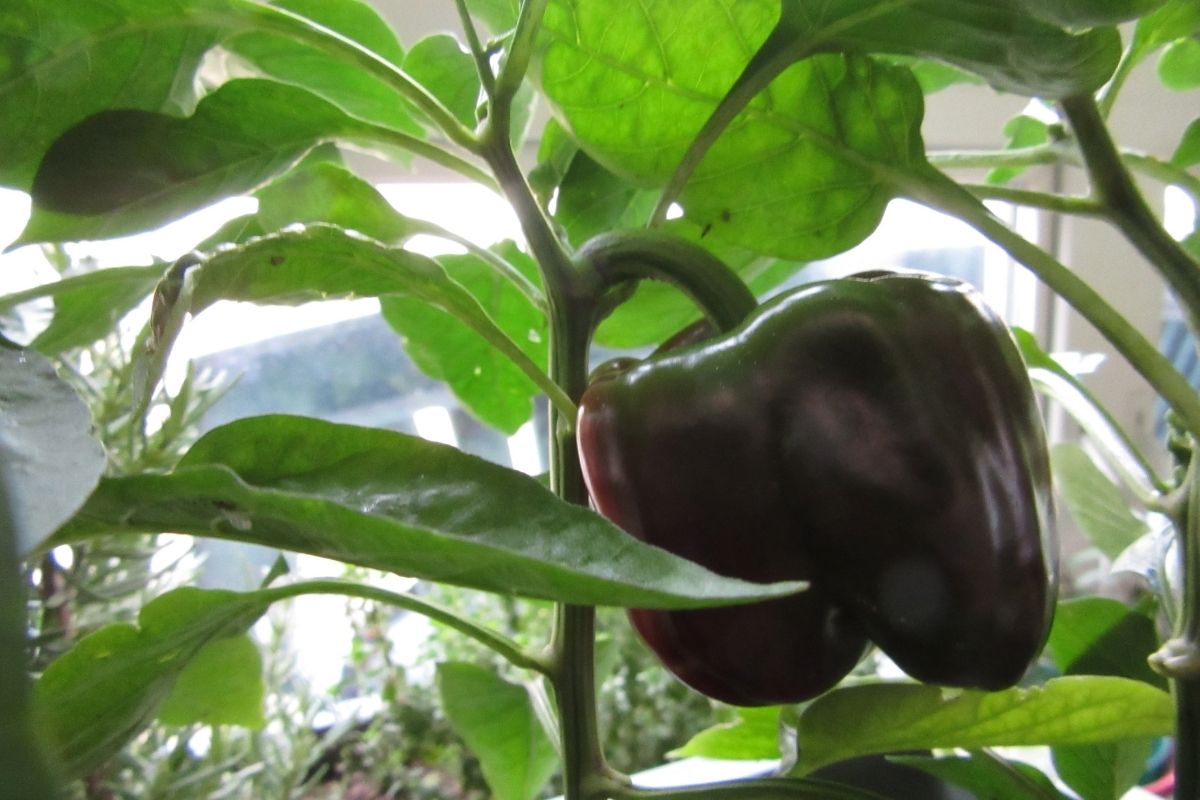Nothing beats homegrown fruit and vegetables. And bell peppers are not only a firm favourite for gardeners, but they’re also relatively easy to grow.
Not to mention the fact that they are delicious when harvested and served in a salad or a stir-fry!

But, despite being quite simple, growing bell peppers doesn’t come without its problems. One of the most common issues being the peppers turning from vibrant shades of red, green or yellow to a less-desirable black.
If your bell peppers are turning black, find out why here, and read my advice on how to avoid this – I’ve thrown in some top tips on growing bell peppers for good measure.
What Are Bell Peppers?
Bell peppers, which are native to Central and South America, belong to the nightshade family and they are actually considered a fruit. Being part of the nightshade family also means they are related to chillies and tomatoes.
Bell peppers come in green, yellow, red and orange; they are low in calories and high in antioxidants, vitamin C and other useful minerals.
These delicious peppers can be used in a variety of dishes, but I love nothing more than adding them to a Bolognese (honestly, you have to try it!), to salads, roasted with olive oil, courgettes and onions, or fried up to make fajitas.
How To Grow Bell Peppers
During my first year of attempting to grow bell peppers, I didn’t have a huge amount of success. Scratch that. I had zero success.
I did the classic ‘chuck them in and hope they take’ method. Which, needless to say, didn’t work so well.
But, don’t let my failed first attempt put you off. Bell peppers are actually relatively easy to grow at home. They take a little while to grow, but they are worth the wait.
Top Tips For Growing Bell Peppers
As with many other types of fruits and vegetables you grow at home, bell peppers work best when started off indoors or grown in a greenhouse – especially if you live in a cooler climate.
Sow your seeds indoors between February and April to harvest them in the late summer and early autumn months.
Begin by sowing them in a seed tray or in small pots. Adding a plastic lid, or covering with a clear plastic bag, can be helpful for keeping them warm and moist.
When the seeds start to sprout, remove the covering and allow them access to full sunlight, watering regularly.
As the plants reach around 3inches in height, and the weather has started to warm (and there’s no longer any risk of frost), you can transplant them outside. Pop them in an area where they will be warm, but can also benefit from the shade.
Remember, you will need to help the young plants acclimatise to the outside conditions, by ‘hardening them’, over a period of 2-3 weeks before they are left outside.
Be sure to continue to water your bell pepper plants regularly, but don’t over-water them.

But Why Are My Bell Peppers Turning Black?
There are a few reasons why your bell peppers may be turning black.
The first is that it’s simply part of the natural ripening process. Green peppers, for example, may turn black before transforming into yellow or red bell peppers. So this is completely normal as long as your pepper seems healthy.
If your bell peppers are exposed to too much sunlight, or extreme cold temperatures, this can also cause them to turn black.
However, if you see that your bell peppers are turning black at the tip, this is a different situation entirely and may be a sign that your plant is suffering from blossom end rot.
What is Blossom End Rot?
Blossom end rot is a common problem for peppers, tomatoes and aubergines.
It presents itself as a circular greenish to black spot when the flower would have previously been (or the blossom).
It is not a disease, but is rather caused by unsatisfactory growing conditions. It is triggered due to a lack of calcium in the fruits.
While most potting soils and grow bags will have plenty of calcium, there also needs to be a good flow of water so that the plant can fully benefit from this mineral.
Unfortunately, when blossom end rot has set in, there’s no way to save the affected bell pepper. But, you can protect the rest of the crop by ensuring you are regularly watering your plants – aim for the soil to always remain moist, especially on warmer days.
Other Common Problems When Growing Bell Peppers
There are a few other issues to be aware of when growing bell peppers at home. These include:
- Aphids and Whitefly: These pests can be found clustering under the leaves of your bell peppers. Not only do their excretions attract other insects, but they can also cause damage to the leaves on your plant, causing them to wilt.
- Slugs: Every gardener’s nightmare! Sluggish will enjoy feasting on your bell pepper leaves and can cause significant damage if you don’t curb the problem.
- Mosaic Virus: Pale and papery, thin-looking leaves can be a sign of mosaic virus. You may also notice spots or streaks on the leaves. Mosaic virus can be transported by pesky aphids. To keep your crop safe, try to keep aphids at bay and, should you notice any signs of mosaic virus, remove the affected seedlings and cover any healthy ones that remain.
Final Thoughts
Bell peppers are a great fruit to grow at home. They are delicious and can help to create a balanced and healthy diet.
Although they are pretty easy to grow, getting the conditions right for them to succeed is essential.
Remember that if your bell peppers are turning black, this may be due to the ripening process. But, if they present with black spots where the flower once was, this is probably an indication of blossom end rot.
- Can You Grow Bell Peppers Indoors? A Guide For New Gardeners - November 14, 2023
- Composting Basics: Can You Compost Mushrooms? - November 6, 2023
- A Gardener’s Guide To Growing Carrots In Raised Beds - November 1, 2023







